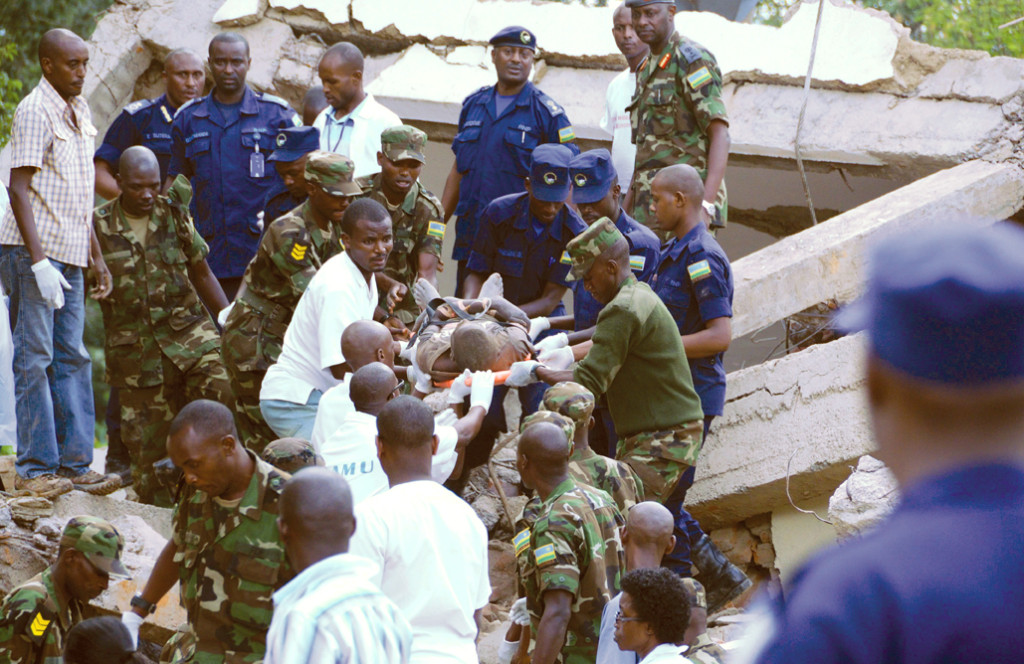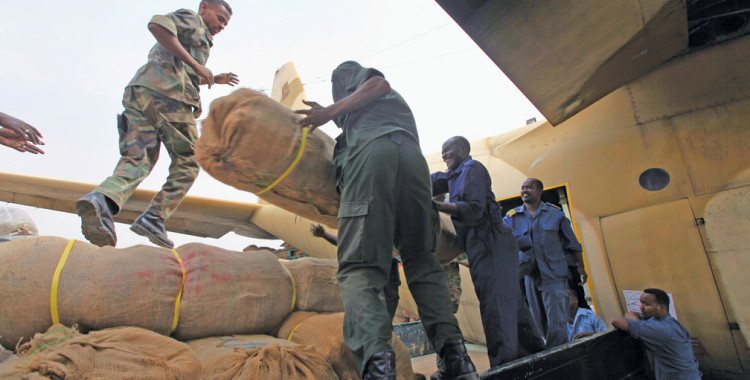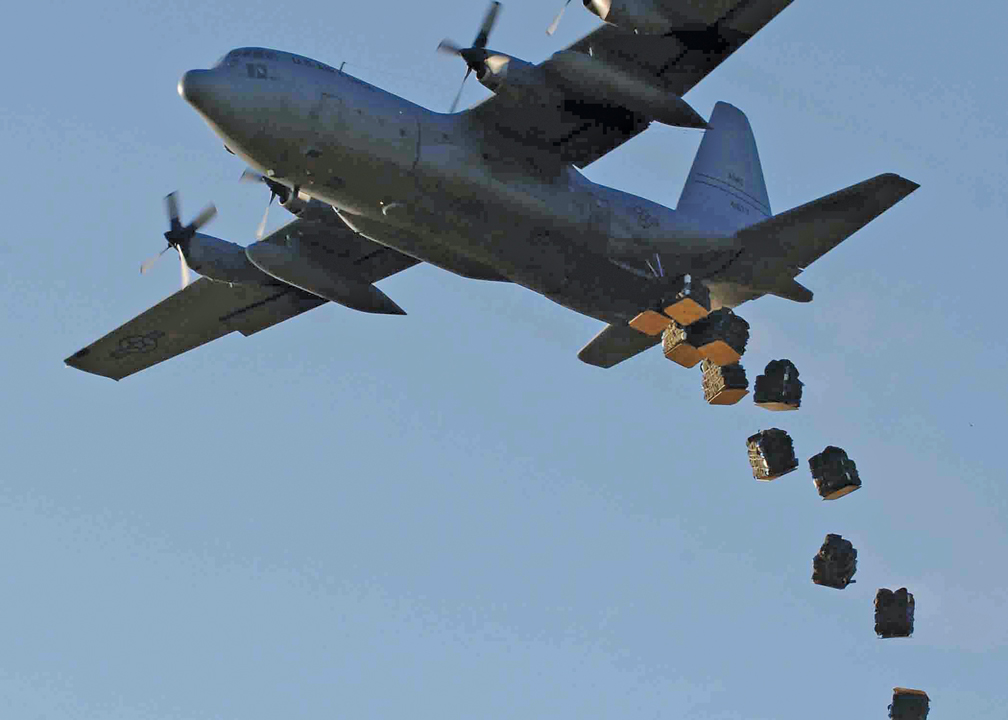Uganda’s National Emergency Coordination and Operations Centre Offers a Model
ADF STAFF

“It was an early warning; it was a wake-up call, and it really activated us to check our capabilities,” said Maj. Gen. Julius Oketta, director of the country’s National Emergency Coordination and Operations Centre (NECOC). “And we found that yes, if it had happened, we didn’t have the adequate capability.”

“We asked each of them to report the capabilities they have in case of earthquake, in case there is flood, in case any other emergency comes,” he said in a September 2013 interview with ADF. “So right now we are aggregating the capabilities of all the institutions in the government: Who has capability for what? I’m developing right now a standard operating procedure and emergency operations plan, which will include all those emergency service functions — where the gaps are and what we need, so each agency can play their role without conflicting with each other.”
The NECOC will be at the heart of coordinating a disaster response in Uganda. Oketta said the center, founded in 2010, is still developing enough capacity to respond to the multiple threats facing the country including seismic activity, floods, landslides, droughts, fire and disease. An estimated 200,000 Ugandans are affected each year by disasters.
Oketta said a properly functioning emergency operations center should focus on command and control. It must give officials the ability to assimilate diverse data and allocate resources across the country, especially at times when infrastructure is damaged or destroyed.
Uganda’s NECOC is working to develop the following capabilities:
- The ability to communicate 24 hours a day with District Emergency Coordination and Operations Centres at district police stations across the country. Communication will be through satellite phone, mobile phone, radio and Internet.
- Building an early warning system that incorporates data gathered at the village level, satellite weather information, and hydrological, geological and other data to forecast disasters.
- Operating a 24-hour hotline with which civilians and Uganda Red Cross representatives can alert officials to imminent disasters.
- Setting up strategic stockpiles of emergency response equipment across the country.
- Training 20 percent of Soldiers in the Uganda People’s Defence Force and 20 percent of police officers on rescue and emergency response. The country, in partnership with U.S. Africa Command, also has trained Soldiers to respond to chemical, biological, radiological and nuclear threats.
- Preparing a mobile unit to be deployed in Uganda or to another East African country in the event of a disaster.
Oketta said the NECOC is now running at about 40 percent of its projected capability in terms of technology and 55 percent in terms of human resources. About 150 people –– 80 percent of whom are civilians –– have been trained to operate the center. “The best thing is to look at how you can have a high capability at a low cost,” Oketta said. “In order to make the center effective, the center should be playing the role of coordination and coordinating the response from the area where you pull the capabilities.”
![[ADF ILLUSTRATION]](https://adf-magazine.com/wp-content/uploads/2014/02/UgandaGraph-923x1024.jpg)
Emergency Operations Centers (EOCs) like the one in Uganda are intended to be the central nerve centers from which disaster response can be coordinated. Equipped with a range of communications and monitoring systems, EOCs should be where disaster response professionals disseminate warnings, coordinate emergency operations between agencies and outside organizations, generate maps, and collect real-time data. The centers are also where civilian officials can be briefed on a disaster’s impact so they can prioritize response areas and allocate resources.
As public safety researcher William Shouldis wrote in a 2010 study, “The EOC mobilizes people and equipment to handle incidents that are outside the ability of any single agency to resolve.” Shouldis said there are three basic types of EOCs:
A fixed facility is usually anchored in a multipurpose government building at an easily accessed location to reduce the response time of the leaders who staff it. It is permanently equipped with the tools to respond to a disaster.
A mobile EOC is used when a disaster is widespread and on-the-scene management and briefings are necessary. A tractor-trailer is the ideal setup for such a center. It should be equipped with a full communications center that can tie together multiple radio frequencies. It should have a security camera system for self-monitoring.
A virtual EOC (VEOC) relies on cyberspace instead of a traditional physical facility or mobile unit (see sidebar, page 25). A VEOC communicates via the Internet, intranet/virtual private networks, smartphones and satellite phones. Authorized people have “anytime, anywhere” access with a user name, password and secure server. A VEOC can reduce response times and best use available resources.
The standard operating procedures for responding to a disaster should be drilled home, Shouldis said. Training should also emphasize the chain of command and the proper decision-making process so all parties are clear on who is in charge. “It has been repeatedly shown that during an incident, most workers remember what they practiced instead of what they were told or have read,” Shouldis said.
The Military’s Role
In countries like Uganda, the military plays a key role in staffing the EOC and responding to disasters. That’s a relatively recent development, because using militaries in times of natural disasters hasn’t always been encouraged. A 2003 study by the humanitarian aid group Oxfam International concluded: “Military involvement can compromise the effective delivery of humanitarian aid and risk unintended consequences. Designed to have quick impact, military-delivered aid is frequently more costly and fails to take into account communities’ long-term needs.”
Disasters in the past 10 years have changed that thinking. A 2012 Brookings Institution paper by Elizabeth Ferris quoted a United Nations official saying, “The battle to keep the military out of disaster response was lost long ago. And the fact is that in natural disasters you need the military. You need to figure out ways to work with the military so that their assets are used effectively and they don’t complicate matters for civilian responders.”
Armed forces have successfully played a central role in responding to natural disasters for years, including the 1991 cyclone in Bangladesh; Hurricane Katrina in the United States in 2005; and the Japanese earthquake, tsunami and nuclear accident in 2011. Africa’s militaries, including Kenya, Mozambique and South Africa, have been a critical resource in rescuing flood victims in the past decade.
Militaries have gotten involved in natural disaster response because they have the equipment and the resources. But there are other valid reasons for helping out. Disaster aid can improve relations between the military and the population. It gives the military the chance to demonstrate its relevance and versatility. Disaster responses offer training opportunities, and when militaries come to the aid of other countries, they act as the best of ambassadors, forging new alliances and reinforcing old ones.
Ferris noted that when the Japanese Self Defense Forces responded to the Japanese disasters in 2011, they were widely praised and “could in the longer term lead to broader public support for defense spending.”
In most countries, especially those in Africa, it is impractical and illogical to duplicate assets the military already has. In times of natural disaster, the military brings its transportation, communications, logistics and security equipment in addition to its training. Militaries often arrive equipped with their own life-support systems, their own emergency rations and their own surveillance systems.
There also are intangible aspects to the military’s role. Researcher Wiley C. Thompson noted in 2008 that militaries also seem to have a way of working together that civil authorities may not possess.
“A benefit of working with other military organizations is that regardless of national origin, they seem to understand each other,” Thompson wrote. “In military parlance, they ‘get it.’ Chain of command, mission orders, security, communications and coordination are all concepts which are components of professional military organizations. Military relief providers can use this common ground as a basis upon which they can quickly form a cooperative working relationship.”
Study after study concludes one thing: No organization can match the military when it comes to the speed of disaster response. It’s because the military has standing forces. Ferris noted that after the 2008 Sichuan earthquake, Chinese forces mobilized within 14 minutes.
But the military cannot, and should not, do it alone. It should be part of a crisis response team. NGOs have noted that although a military might be outstanding at reopening airports and ports after a disaster, it might not be so good at coordinating the distribution of relief supplies. Although militaries are the best first responders during a natural disaster, they can overstay their welcome when the crisis passes. It’s important to know when to let civil authorities, local governments and NGOs take over. Ideally, these groups work as a team through a crisis response center.
Virtual Centers Offer Instant Access
ADF STAFF
Conventional Emergency Operation Centers (EOCs) are based in a building, typically a government-owned facility, or in a mobile unit, such as one or two trailers driven to the scene of a natural disaster. But a third type of EOC is now feasible, the virtual EOC (VEOC).
The center exists solely or partially in cyberspace. It can consist of one workstation or thousands of networked computers around the world. The first versions of VEOCs were simple information systems based on fixed and mobile wireless networks. Modern VEOCs use the latest Internet technology and satellite communications.
Even in the most remote parts of the world, far from access to any networks or cell towers, contact with a VEOC is possible via satellite.
Command center participants share information, make decisions and deploy resources without having to be present in a traditional center. Participants can work from home or from the field. They also can work from the scene of a crisis as it unfolds.
Information is collected in a central database that is available to team members from anywhere in the world. The team leader and network technician can be based anywhere. A VEOC can protect communication and data with needed redundancy, security and flexibility.
VEOCs can use a variety of technology and communications options:
- Internet, intranet/virtual private network, wireless
- Radio, cellular, satellite
- Mapping
- Automated journaling
- Access to plans and data
Conference calls, emails and automated systems are generally used to communicate. The automated systems can use standard categories to route reports to the appropriate positions. Emergency managers receive and evaluate information from inside and outside the enterprise, and the system can manage information in real time to keep records as events unfold.
Satellite services can provide high-speed telecommunications where traditional computer and cellphone systems are disrupted or nonexistent. With a message-sorting and distribution capability, emergency managers can track and log multiple and varied notifications and ensure that the right information gets to the right person.
Sources: DavisLogic Inc., “The Emergency Operations Center: A Vital Preparedness Tool,” by Williams Shouldis; “A Brand New World,” by Regina Phelps
Africa’s Disaster Operation Centers
Africa’s disaster operation centers are in various stages of organization and implementation. Here is a sampling of the continent’s centers:
THE GAMBIA — The Gambia endures torrential rains almost every year. Annual flooding claims lives and property, and buildings collapse. The National Disaster Management Agency coordinates disaster responses with the Maintenance Services Agency to get people more involved in protecting themselves and their property.
KENYA — The National Disaster Operation Centre partnered in May 2013 with a communication infrastructure company to establish a camera surveillance system for early detection and monitoring of disasters in urban areas. BizTechAfrica reported that the surveillance center will include links to cameras on and inside high-rise buildings, major roads and highways, football stadiums, shopping malls, railway stations, and airports. In July 2013, the center unveiled a new database to monitor and record disasters, including floods and fires, and coordinate relief efforts quickly and efficiently.
LIBERIA — After years of inactivity, Liberia’s National Disaster Relief Commission has begun responding to storms and other natural disasters, as well as launching a “Making Cities Resilient Campaign” in 2012.
MOZAMBIQUE — Mozambique has regular problems with floods, and the National Disasters Management Institute was formed in 1999 to anticipate and manage such problems.
NAMIBIA — Namibia is the driest country in Sub-Saharan Africa, making accurate climate forecasts critical. In 2011, the country launched the Earth Observation and Satellite Applications Research and Training Centre to help prepare for droughts, floods, brush fires and pests. The center is housed at the Polytechnic of Namibia and includes a satellite data-receiving station.
NIGERIA — Nigeria’s National Emergency Management Agency has been conducting vulnerability studies, and in August 2013 it identified 90 areas of the country that would be vulnerable to flooding for the remainder of the year. The agency had begun a “sensitization exercise” on early warnings and prevention in the at-risk regions. The study showed that 2013 rain levels would be higher than they were in 2012, particularly in the northern states.
In June 2013, the United Nations reported that NEMA had asked the U.N. Office for Disaster Risk Reduction for help with a comprehensive disaster risk management plan. U.N. officials said that Africa’s most-populous nation is particularly concerned with preventive measures in adapting to disasters and climate change. Nigerian Vice President Namadi Sambo said, “It is time to come back to what the wise man said: Prevention is better than cure.”
SENEGAL — The Senegalese Civil Protection Agency announced in 2012 that it was trying to establish a culture of “proactive preparedness” rather than just responding to disasters as they developed. With help from the World Bank’s Global Facility for Disaster Reduction and Recovery, Senegal launched a $1.1 million Disaster Risk Management and Climate Change Adaptation project to go along with a $55.5 million credit agreement with the World Bank for improved drainage in Dakar’s suburbs.
The country is vulnerable to flooding, rising sea levels along its coastline, droughts and locust infestations. Flooding in and around Dakar in 2009 caused more than $100 million in damage.
SOMALIA — The Somali Disaster Management Agency is perhaps the newest disaster center on the continent, approved by the country’s Cabinet on May 30, 2013. It is part of a larger effort by the country to re-establish national institutions after decades of fighting.
SOUTH AFRICA — The South African National Disaster Management Centre ensures that the country’s Disaster Management Act is carried out. It has become the focal point for all South Africans involved in disaster management and contributes to the “preservation of lives, natural heritage and the environment.”
TANZANIA — Tanzania established the Disaster Management Department in 1990 to coordinate disaster relief and conduct research. The department conducted a study in 2001 and determined that the country’s greatest natural threats include epidemics, pest infestation, droughts and famines, floods, fires, cyclones, earthquakes, landslides, and refugees.
The terrorist bombing of the U.S. Embassy in Dar es Salaam in 1998 revealed weaknesses in the country’s disaster preparedness and response capabilities. As a result, the department implemented a 30-month program in 2001 to improve its responses.
ZAMBIA — Zambia established its Disaster Management and Mitigation Unit in 1994. The unit works closely with UNICEF to anticipate and minimize the effects of natural disasters. Flooding has been a special focus, along with cholera, which often comes after flooding. The unit was initially established to centralize procedures and avoid duplication of efforts and resources.
In May 2013, the Times of Zambia reported that the unit had dispatched 40 vulnerability assessment committee teams to 44 out of 100 districts throughout the country to assess damage caused by dry spells or flooding.
ZIMBABWE — The mission of Zimbabwe’s Civil Protection Directorate is to coordinate and promote strategic planning for emergencies “through regulatory mechanisms in order to provide for and ensure optimal emergency preparedness and disaster prevention.” The center’s mandate is to promote planning, particularly for flooding. The center regularly provides reports on major incidents associated with the rainy season.
Information compiled from open-source data by ADF.

